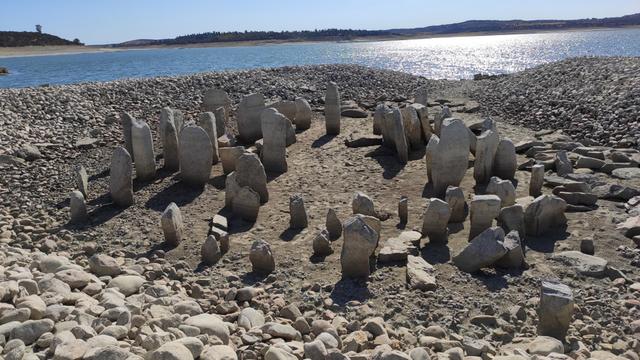https://www.europesays.com/uk/330692/ Ancient viral DNA may play a key role in early human development, new study suggests #AncientViruses #GeneExpression #GeneticCode #GeneticInformation #Genetics #GenomeEvolution #HumanDiseases #HumanEvolution #HumanGenome #researchers #Science #TEs #TransposableElements #UK #UnitedKingdom #ViralDNA #XunChen
#humanevolution
Neanderthal genes linked to rare brain-skull disorder, study finds
A recent study shows that Neanderthal DNA from ancient times can cause a neurological condition known as Chiari Malformation Type I (CM-I), where a part of the brain protrudes through the base of the skull into the spinal canal...
More information: https://archaeologymag.com/2025/07/neanderthal-genes-linked-to-brain-skull-disorder/
Follow @archaeology
Ancient stone tools suggest early humans inhabited Sulawesi more than a million years ago
Ancient humans lived on the Indonesian island of Sulawesi at least a million years ago — 800,000 years…
#NewsBeep #News #Science #ancienthumans #archaeology #AU #Australia #fossils #hominins #humanancestor #humanevolution #Indonesia #SouthEastAsia #stonetools #Sulawesi
https://www.newsbeep.com/au/49003/
“Mom and Grandma were keeping the kids fed, not man the hunter. …grandmothers and babies were sharing food, cooperating and developing new social relationships…”
—John Poole, For Human Evolution, Root-Gathering Grandmas May Have Been More Important Than Man The Hunter
https://www.npr.org/sections/goatsandsoda/2018/06/07/617097908/why-grandmothers-may-hold-the-key-to-human-evolution
#relationships #humanevolution
Did you know that humans have one less pair of chromosomes than the other apes?
At some point (slightly less than a million years ago iirc) someone was born with two chromosome pairs fused end to end - and it not just worked but worked so well it took over completely for the whole population. So it had to have been at least initially fully compatible with not having them fused, or else that person wouldn't have had fertile kids.
The “Spanish Stonehenge” — older than both Stonehenge and the pyramids — has emerged from a shrinking reservoir. Its age suggests megalithic civilisations were thriving in Europe far earlier than we thought. Maybe we’ve had human history backwards all along.
#Archaeology #HumanEvolution #ClimateCrisis
https://www.livescience.com/Spanish-stonehenge-dolmen-de-guadalperal.html

It's publication day! New piece where we explore the pushes and pulls that incentivize innovation. We propose several inflection points in human history where novel technological solutions may have led to extraordinary changes to life history and sociality.
#humanevolution #anthropology #technology #innovation #archaeology #humanecology #pyrotechnology
https://onlinelibrary.wiley.com/doi/10.1002/evan.70006
DM for pdf copy.
Evolution advances, not by a priori design, but by the selection of what works best out of whatever choices offer. We are the products of editing, rather than of authorship.
-- George Wald (The Origin of Optical Activity)
Mysterious pits on 2-million-year-old fossil teeth unlock clues to human evolution
The bizarre pattern of tiny pits on fossil teeth, once thought to be signs of disease or malnutrition, might actually hold a genetic key to unlocking our evolutionary history...
More information: https://archaeologymag.com/2025/06/mysterious-pits-on-2-million-year-old-fossil-teeth/
Follow @archaeology
What Did Neanderthals Think About Before Bed?
Imagine a world that looks nothing like the one we know today. It’s a place where surviving the day isn’t a metaphor—it’s a real struggle. When the sun goes down, it gets truly dark, much darker than anything we’re used to. As night falls, your priorities change. You’re not thinking about homework, crushes, or weekend plans. You’re thinking about how to stay alive. That’s what life was like for Neanderthals. When they gathered around the fire at night, their thoughts were all about survival, safety, and protecting their families.
Fire: More Than Just Heat
For Neanderthals, fire wasn’t just about staying warm or cooking food—it was life-saving. It kept dangerous animals away and gave the group a place to come together. Sitting by the fire, you might have watched the flames and wondered if they’d be enough to scare off predators like hyenas or cave bears.
Fire also made people feel safe. Its light pushed back the darkness of the cave and gave everyone a place to relax, even just for a little while. You might think about tomorrow’s hunt and what you’d need to do to make it successful. You might also start sharing stories—maybe about the hunt you just came back from or something strange you saw. The fire made people feel connected and calm.
Family: The Heart of It All
Your family would be sitting close to you by the fire. Their presence would bring comfort. In Neanderthal life, family wasn’t just important—it was everything. As you looked at them in the firelight, you’d probably be wondering if everyone had enough to eat, if the younger ones were safe, and how to protect them better tomorrow.
Maybe you’d plan how to find more food or make your shelter stronger. You’d notice if someone seemed worried or cold. Being aware of each other’s needs wasn’t just nice—it was necessary. Everyone had to work together, from the oldest to the youngest. That cooperation is what kept the group alive.
Staying Safe: A Full-Time Job
Neanderthals couldn’t take safety for granted. There were always threats—from animals, bad weather, or even other groups. As you started to get sleepy, your mind would probably still be alert, thinking about what dangers might be out there in the dark.
You’d go over what happened during the day: a risky moment during a hunt or a tough climb over rocky terrain. Your brain, shaped by years of experience and learning, would use these moments to figure out how to do better next time. Every mistake could be a big one, so learning quickly was important.
Dreams and the Night Mind
Even in tough times, dreams mattered. Neanderthals probably dreamed just like we do. Maybe dreams gave them a chance to imagine, solve problems, or revisit the day’s events. Some dreams may have felt important—like warnings or signs.
They might have even helped Neanderthals practice for real-life situations: how to hunt better, avoid danger, or deal with others. Dreams could have also planted the seeds of early stories—ways to share knowledge and experiences with others.
Looking Back on the Day
Lying near the fire, you might think about what went well that day. Did you help catch an animal for dinner? Did you finish a tool that works better than your old one? Remembering these successes would give you hope and confidence.
These thoughts helped people feel proud and reminded them they were valuable to their group. Feeling like you belonged and had a purpose was important—even back then.
Watching the World
Neanderthals paid close attention to nature. At night, by the fire, you’d think about the world around you—how animals moved, what the sky looked like, and how the weather was changing. Knowing these things helped your group plan and stay safe.
You might look up at the stars, wondering if they meant something. Maybe they helped you find your way, or just gave you something to think about. This curiosity about nature helped build early knowledge and respect for the land.
People Around the Fire
The fire wasn’t just for warmth—it was a social space. Neanderthals probably talked, shared advice, told stories, and taught each other new skills. These times helped build stronger friendships and group unity.
You might think about who in your group you trust the most or how to help someone who’s struggling. Making sure everyone worked well together was key to surviving. Your final thoughts of the night might be about how to keep your group strong.
What You Leave Behind
Even though Neanderthals didn’t think about legacy the way we do today, they still wanted to pass on what they knew. As you watched the younger ones by the fire, you’d hope they were learning what they needed to stay safe and strong.
You’d pass down your knowledge through stories, by showing them how to use tools, and by helping them understand the world. That was your way of making sure your life meant something.
Our Shared Story
All these thoughts and experiences show that Neanderthals were a lot more like us than people used to think. They had emotions, deep connections with others, and a strong sense of community. They thought about their day, worried about the future, and cared deeply for their families.
Even though our lives are very different now, we still stay up late thinking about our relationships, our goals, and what tomorrow will bring. That’s something we share with our ancient cousins. So next time you’re lying in bed, wondering about your day, remember: thousands of years ago, someone else sat by a fire, doing the exact same thing.
#NeanderthalNights #HumanOrigins #PaleoPost
References
- Finlayson, C. (2014). The Improbable Primate: How Water Shaped Human Evolution. Oxford University Press.
- Stringer, C., & Gamble, C. (1993). In Search of the Neanderthals: Solving the Puzzle of Human Origins. Thames and Hudson.
- Wrangham, R. (2009). Catching Fire: How Cooking Made Us Human. Basic Books.
- Zilhão, J., et al. (2010). Symbolic use of marine shells and mineral pigments by Iberian Neanderthals. Proceedings of the National Academy of Sciences, 107(3), 1023-1028.
The other homo sapiens...
We are just one branch of a diverse human family tree. Aside from Neanderthals, who were they – and why did we replace them?
We may live in civilisation today, but the genes within us are those that made us the sole survivors of hundreds of thousands of years of intertribal conflicts and bloody, genocidal wars. We replaced all the other humans because we were more dangerous than all the others.
And we still are.
#homosapiens #humanevolution #archaelogy #anthropology
https://aeon.co/essays/why-one-branch-on-the-human-family-tree-replaced-all-the-others
780,000-Year-Old Discovery Shakes Up Human Diet History
New evidence from Israel’s Gesher Benot Ya’aqov site reveals early humans relied heavily on plants, not just meat. Researchers found preserved remains of 55 different food plants, showing our ancestors had a varied, nutrient-rich vegetarian diet 780,000 years ago.
This challenges the "caveman diet" stereotype and proves plant-based nutrition has been key to human survival for millennia. #HumanEvolution #PaleoDiet #Archaeology
https://scitechdaily.com/780000-year-old-discovery-reveals-that-early-humans-thrived-on-a-plant-based-diet/
Scientists uncover a hidden chapter in human evolution through genetics. Our ancestry just got even more fascinating!
#HumanEvolution #GeneticDiscovery
https://www.earth.com/news/hidden-chapter-in-human-evolution-revealed-through-genetics/
If you like thinking and learning about human prehistory, you'll like this interview with geneticist David Reich. Two hours on what research tells us about human origins, how modern humans relate to Neanderthals and Denisovans, ancient DNA, ancient epidemics, admixture, how genetics informs archaeology, and the spread of the Yamnaya from the steppes.
New fossil evidence reveals that Neanderthals cared for a 6-year-old with Down syndrome, challenging stereotypes of these ancient humans. This discovery highlights their capacity for empathy, social bonds, and care for individuals with special needs. A profound reminder of shared humanity across millennia. #Neanderthals #HumanEvolution #Archaeology
https://www.livescience.com/archaeology/neanderthals-cared-for-6-year-old-with-down-syndrome-fossil-find-reveals
Did art save Homo Sapiens? In the #SciencePodcast, Prof. Nicholas Conard explores how creativity gave us a survival edge. “Every group of human beings we know today has art.” Tune in for insights on Paleolithic archaeology and the origins of our species. https://uni-tuebingen.de/en/exzellenzstrategie/podcasts/science-podcast-key-to-my-research/ #Archaeology #HumanEvolution #ExStra #Podcast
„Urban Roboters“ (2014)
Zurich, Switzerland
Photo Dietmar Bachmann
Ancient Art of Tassili n’Ajjer: 12,000-Year-Old Window into Sahara’s Past
Discover the ancient cave paintings of Tassili n’Ajjer in Algeria’s Sahara Desert, a UNESCO World Heritage Site featuring over 15,000 prehistoric artworks. These stunning engravings and drawings, dating back 12,000 years, reveal insights into early human life, climate change, and the region’s once-lush environment. Explore this lunar-like landscape of sandstone formations and humanity’s enduring creativity.
I like how natural this guy brings this.
NeuroEverything: *Why We're 99.9% Genetically Identical, Explained By Science & History*
"Ever wondered why #humans share 99.9% of their #DNA? Not all animals are this genetically similar. In fact Homo sapiens are some of the most genetically similar species out there. In this video, I'll describe #humanity's origins from our making it out of #Africa to us returning again in the wake of the Youngest Toba super-volcanic eruption—and how events like it—created population bottlenecks that reduced our genetic diversity, making us more alike than we've ever been before. Longest video I've ever made. Have fun!"
Our Bigger Brains Came With a Downside: Faster Aging.
A study comparing chimpanzee and human brains suggests that the regions that grew the most during human evolution are the most susceptible to aging.

